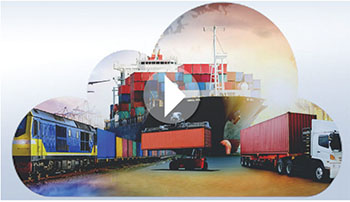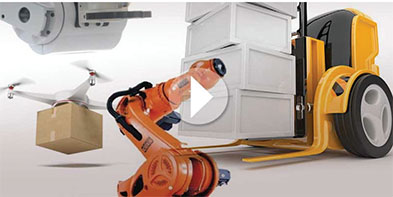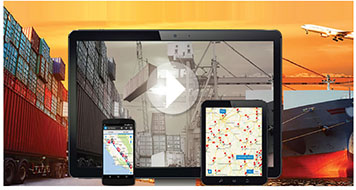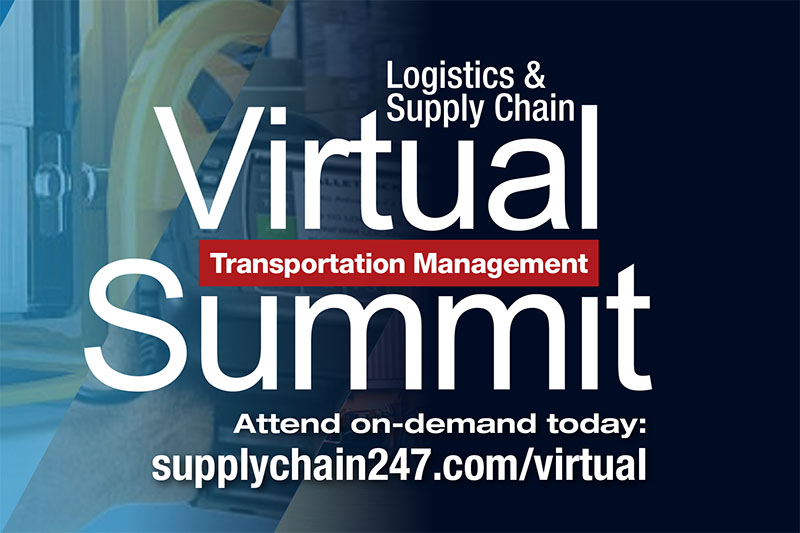Transportation Management Virtual Summit Roundup
This year’s summit shows attendees how to kick their company’s digital transformation into overdrive in 2020.
The global supply chain is a pretty dynamic place right now. The continual uptick in e-commerce sales; the ever-shrinking delivery windows; the national labor shortage; and geopolitical issues like Brexit and the trade wars are all having an impact on this crucial business network. Add Industry 4.0, the Internet of Things (IoT), automation and artificial intelligence (AI) to the mix and the supply chain environment becomes even more complex and confusing.
Always standing by to help professionals unravel the mysteries of the smooth-running supply chain, Peerless Media once again rolled out an impressive lineup of topics and experts for its annual Virtual Summit. This year, the event put the spotlight on the digitalization of logistics and supply chain operations.
With respondents to Logistics Management’s recent “Study of Logistics and Transportation Trends” suggesting there’s been a general shift toward firms opting to “follow” instead of taking a leadership role with digitalization, the event was both on target and relevant for a wide range of supply chain professionals.
The question is, with the number of available and emerging digital solutions multiplying almost daily, why are many organizations still spinning their wheels instead of driving forward? The Virtual Summit keynote speakers set out to answer this question by sharing the findings of this year’s survey. They also offer supply chain professionals some great tips for kicking their digital transformations into overdrive.
Here’s a snapshot of each presentation and the key takeaways offered by the experts who participated in the Virtual Summit.
Session 1
Artificial intelligence and machine learning
 Technical concepts that promise to propel supply chain organizations into the future by allowing them to synchronize and optimize automated processes; evaluate multiple scenario outcomes; and improve real-time decision-making, artificial intelligence (AI) and machine learning (ML) are having a significant impact on global supply chain management.
Technical concepts that promise to propel supply chain organizations into the future by allowing them to synchronize and optimize automated processes; evaluate multiple scenario outcomes; and improve real-time decision-making, artificial intelligence (AI) and machine learning (ML) are having a significant impact on global supply chain management.
Armed with these advanced technology tools, organizations can effectively analyze vast amounts of data, make better decisions, spot trends and even predict events before they actually happen. In this opening session, Sergio Alex Caballero, Ph.D., research scientist at MIT’s Center for Transportation & Logistics provides a fundamental overview of AI and ML and how these two powerful concepts can be applied to logistics and supply chain management operations.
“Artificial intelligence seems to be everywhere,” says Caballero. “We experience it at home, at work and on our phones. Before we know it, AI will be in every product and service that we buy and use.” He goes on to say that AI is also everywhere in our personal lives—from music predictions, to Google maps knowing the traffic, to chatbots to fraud-prevention tools.
The ability of a machine to perform cognitive functions associated with human minds, AI isn’t new. In fact, it traces back to the 1950s and is rooted in the idea that machines can indeed learn how to do human tasks. Fast-forward to 2020 and AI now has the potential to disrupt many industries because of its predictive ability. “Algorithmic advances, data proliferation, computer power and data storage have all propelled AI from hype to reality,” Caballero says.
As part of that forward motion, AI is helping companies predict what’s going to happen in their supply chains. “Prediction used to be expensive, but it becomes more disruptive as it becomes cheaper and easier to produce,” Caballero says, adding that the supply chain is a hotbed for this technology because it tends to produce a lot of data. He concludes by discussing how, as AI expands, supply chains will shift over to a “proactive and predictive paradigm through better visibility and enhanced prediction.”
Session 2
Taking a Cloud-first approach
 Early on, companies were concerned about “losing control” over their data once it went into the Cloud, and that such data would be especially prone to breaches and hackers. However, as this software delivery method matured—and as technology vendors shored up their systems and addressed key concerns—those early fears were overshadowed by the sheer benefits of moving from on-premise software to Cloud-based solutions.
Early on, companies were concerned about “losing control” over their data once it went into the Cloud, and that such data would be especially prone to breaches and hackers. However, as this software delivery method matured—and as technology vendors shored up their systems and addressed key concerns—those early fears were overshadowed by the sheer benefits of moving from on-premise software to Cloud-based solutions.
In this session, Gartner Research vice president Dwight Klappich dives into the fundamentals of Cloud computing; shares the differences between public, private and hybrid Cloud; and explains the myriad benefits that a Cloud-first approach can bring to the modern supply chain organization.
“The Cloud has had a significant impact on supply chain and logistics, but is not as widespread as predicted a few years ago,” says Klappich, who walked attendees through the evolution of Cloud technology and how it has transformed into different areas (both the private and public Clouds).
According to Klappich, 62% of companies currently have at least one supply chain application in the Cloud. “Companies have shown a lot of resistance before implementing their first Cloud app, but resistance really decreases once they have at least one,” he says, noting that there are still some companies that have yet to adopt Cloud-based applications because they don’t think it’s the right option for their organizations; have data security concerns about it; or have IT teams that don’t support that deployment model.
Session 3
Robotics: From the “point of activity” to “a place of innovation”
 As the challenges of e-commerce fulfillment continue to mount, and as labor becomes more difficult to find and retain, a growing number of companies are turning to automation for help. As part of that push, early adopters are helping to propel robots out of the “experimental” stage and into real-life warehouse and DC settings. In fact, mobile, unit-handling, and piece-picking robotics are increasingly making their way inside warehouse/DC operations around the United States—and there’s a good chance they’re headed your way.
As the challenges of e-commerce fulfillment continue to mount, and as labor becomes more difficult to find and retain, a growing number of companies are turning to automation for help. As part of that push, early adopters are helping to propel robots out of the “experimental” stage and into real-life warehouse and DC settings. In fact, mobile, unit-handling, and piece-picking robotics are increasingly making their way inside warehouse/DC operations around the United States—and there’s a good chance they’re headed your way.
For the five-year period 2018 to 2023, IDC forecasts a 22.4% compound annual growth rate for pick and pack robotics, culminating in more than $9 billion in spending by 2023. In this session, two of the company’s analysts provide a snapshot of how logistics robotics are operating in today’s facilities. By 2023, 65% of warehousing activities will use robots and situational data analytics to enable storage self-optimization.
They also explore the fundamental value of robotics to supply chain managers; share how early adopters have benefited; and explain how logistics professionals can best determine if a robotics solution is a right fit for their operations. According to Remy Glaisner, research director, and Sampath Kumar Venkataswamy, research manager, the top three reasons organizations deploy robotics solutions are to improve productivity and efficiency, increase the speed of operations and improve product/service quality.
Despite these potential “wins,” robotics adoption remains low—at least for now. “Across sectors, which is pretty consistent with supply chain-centric organizations, about only 30% of enterprises are actively planning the deployment of robotics solutions,” Glaisner says, “and about 25% are piloting such projects.”
Companies may still be using traditional, manual processes at present, but Venkataswamy says that should change with the new emerging technology in the next few years. The session wraps up with a review of the roadblocks to robotic adoption, which include missing skills and expertise and exploiting too-narrow operational use cases. The analysts also present statistics on how robotics have made an impact on standard operational KPIs and have improved warehouse operations.
Session 4
Mobility: Changing the game inside and outside the four walls
 An integral part of today’s business world, mobility is having an impact on every link in the supply chain—from the warehouse/DC to the yard to the transportation network to the last-mile—and everything in between. Mobile devices and the software they run on work together to provide high levels of visibility, reliability and accuracy across the end-to-end supply chain.
An integral part of today’s business world, mobility is having an impact on every link in the supply chain—from the warehouse/DC to the yard to the transportation network to the last-mile—and everything in between. Mobile devices and the software they run on work together to provide high levels of visibility, reliability and accuracy across the end-to-end supply chain.
In return for their increased investment in mobility, logistics and supply chain operations can more readily meet the needs of their increasingly demanding customers, maintain competitive advantage and overcome labor challenges. In this Virtual Summit session, David Krebs, VDC Research’s executive vice president of enterprise mobility shares some of the trends driving the increased use of mobility devices.
Krebs also explains how devices are being put to work inside and outside the warehouse’s four walls, explores the benefits mobility brings to overall supply chain operations, and outlines steps toward making mobility a vital part of a company’s digital transformation. “Mobility is not new; it’s been around for years in different variations,” says Krebs, who points out that mobility helps companies improve productivity, collaboration, supply chain visibility and real-time decision making.
Krebs discusses the most actively-used technology and services today, including mobile-managed services, cyber security, and IoT, to name a few. He says that mobile technology is fueling supply chain performance, and that more organizations are allocating funds to mobile solutions in order to keep up with the rigors of e-commerce, manage the labor shortage and get a leg up on their competitors.
Session 5
Digital freight matching and digitalization
 A concept that’s been around for a few years but really hit its stride in 2019, digital freight matching, or “DFM,” is the ultimate matchmaking machine for independent trucking companies and the shippers that need them to transport their goods. In this final session of the Virtual Summit, Evan Armstrong, president at Armstrong & Associates gives attendees an in-depth look at how DFM works, who’s behind this movement and who is using it.
A concept that’s been around for a few years but really hit its stride in 2019, digital freight matching, or “DFM,” is the ultimate matchmaking machine for independent trucking companies and the shippers that need them to transport their goods. In this final session of the Virtual Summit, Evan Armstrong, president at Armstrong & Associates gives attendees an in-depth look at how DFM works, who’s behind this movement and who is using it.
According to recent reports, the DFM market is expected to surpass $52 billion in annual revenues by 2025—up from $11.2 billion in 2018. After presenting some key survey findings, Armstrong provides an overview of major DFM providers like Convoy, Uber Freight and Transfix. Pointing out that trucking comprises the largest portion of a company’s logistics costs, he says there’s “a lot of interest in DFM right now.”
Going forward, Armstrong says the line between digital freight brokers and “legacy brokers” will continue to blur. “At the end of the day, DFM companies have been very good, especially over the last three years,” says Armstrong. “They have the traditional legacy providers focused on innovating and automating their operations.”

Article Topics
Warehouse News & Resources
The Ultimate WMS Checklist: Find the Perfect Fit 40th Annual Salary Survey: Salary and satisfaction up Data Capture: Bar coding’s new companions Salary Survey: Pay, satisfaction, youth on the rise Examining the impact of the Taiwan earthquake on global supply chain operations Reverse Logistics: Best Practices for Efficient Distribution Center Returns Exploring Customized Forklift Solutions More WarehouseLatest in Logistics
LM Podcast Series: Assessing the freight transportation and logistics markets with Tom Nightingale, AFS Logistics Investor expectations continue to influence supply chain decision-making The Next Big Steps in Supply Chain Digitalization Warehouse/DC Automation & Technology: Time to gain a competitive advantage The Ultimate WMS Checklist: Find the Perfect Fit Under-21 driver pilot program a bust with fleets as FMCSA seeks changes Diesel back over $4 a gallon; Mideast tensions, other worries cited More LogisticsSubscribe to Logistics Management Magazine

Find out what the world's most innovative companies are doing to improve productivity in their plants and distribution centers.
Start your FREE subscription today.
April 2023 Logistics Management

Latest Resources

















